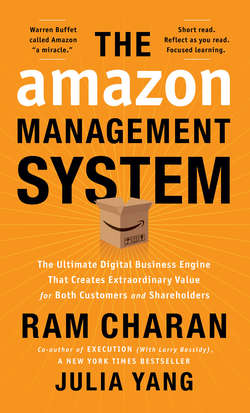Читать книгу The Amazon Management System - Ram Charan - Страница 35
На сайте Литреса книга снята с продажи.
Long-term thinking
Оглавление“It’s all about the long term,” noted Bezos in his first Shareholder Letter, adding, “a fundamental measure of our success will be the shareholder value we create over the long term.” He went on to say that Amazon “will continue to make investment decisions in light of long-term market leadership considerations rather than short-term profitability considerations or short-term Wall Street reactions.”
Why is long-term thinking so important for Amazon? The secret is in the very nature of its business model. Amazon is all about platform and infrastructure. So it is, in essence, a scale business characterized by high fixed costs and relatively low variable costs.
Building platform and infrastructure takes multiple years, and requires massive investments of billions or dozens of billions, if not more. From a short-term perspective, be it quarterly, annually or a two to three-year timeframe, such investments will never be able to generate enough return to cover the initial investments, not to mention generating return. Only those who can think at least seven to ten years out, are able to fully recognize the innate beauty of the platform and infrastructure business: the flywheel, the self-reinforcing mechanism and the exponential growth tilted towards the long term, and thus have the mighty daring to make such massive investments over the long term.
So how to drive the return on such a massive investment? Scale and speed really matter here. Bezos’s Letters to Shareholders up to the time of this writing constantly reinforce this philosophy.
First is scale. Increasing scale “spreads fixed costs across more sales, reducing cost per unit, which makes possible more price reductions.”14 Once the scale passes a certain threshold, what Bezos calls the “tipping point,” it “allows us to launch new ecommerce businesses faster, with a higher quality of customer experience, a lower incremental cost, a higher chance of success, and a faster path to scale and profitability than any other company.”15
That’s why in 1997, in his first Shareholder Letter, Bezos stated “We will balance our focus on growth with emphasis on long-term profitability and capital management. At this stage, we choose to prioritize growth because we believe that scale is central to achieving the potential of our business model.”
Second is speed. Platform and infrastructure are a technology game. Prior investments and faster movements captivate a larger customer base earlier, and accumulate historical data earlier, which translates into significant first-mover advantages in data analytics, algorithm enhancements and AI-driven solutions. In short, all these elements combined create Amazon’s digital core competencies.
Data is the new equity in the digital age. From customers’ data and behavioral analysis, new needs can be identified, better services and experiences can be created and thus more revenue streams can be generated, which further expands the scale, lowers the cost, and increases the return. In fact, each platform must have multiple streams of revenue; otherwise it will never make big money.
Because of its digital core competency, Amazon can continuously improve its operational efficiency while lowering its cost structure, becoming ever more competitive in serving millions more customers. Such faster iterations of continuous improvements create steep, and increasingly higher, entry barriers for latecomers.
That’s why Bezos constantly reminds his team of the importance of velocity, for example emphasizing “greater capital velocity” in the 1997 Shareholder Letter. As the incremental cost of serving more customers converges to almost zero, it’s no wonder that Amazon can totally defy the law of diminishing returns,16 and demonstrate the new law of increasing returns and decreasing incremental costs.
